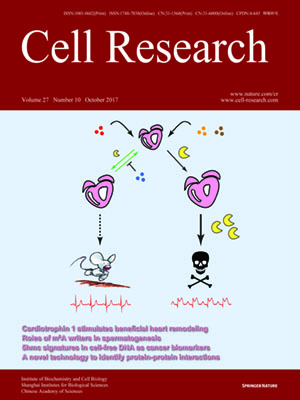
Volume 27, No 10, Oct 2017
ISSN: 1001-0602
EISSN: 1748-7838 2018
impact factor 17.848*
(Clarivate Analytics, 2019)
Volume 27 Issue 10, October 2017: 1293-1297
LETTERS TO THE EDITOR
Altered neurogenesis and disrupted expression of synaptic proteins in prefrontal cortex of SHANK3-deficient non-human primate
Hui Zhao1,2,*, Zhuchi Tu1,3,*, Huijuan Xu1, Sen Yan3, Huanhuan Yan4, Yinghui Zheng1, Weili Yang3, Jiezhao Zheng5, Zhujun Li5, Rui Tian1, Youming Lu4, Xiangyu Guo3, Yong-hui Jiang6, Xiao-Jiang Li1,3,7 and Yong Q Zhang1,2
1State Key Laboratory of Molecular Developmental Biology, Institute of Genetics and Developmental Biology, Chinese Academy of Sciences, Beijing 100101, China
2University of Chinese Academy of Sciences, Beijing 100101, China
3Guangdong-Hongkong-Macau Institute of CNS Regeneration, Ministry of Education CNS Regeneration Collaborative Joint Laboratory, Jinan University, Guangzhou, Guangdong 510632, China
4The Institute for Brain Research, Collaborative Innovation Center for Brain Science, Huazhong University of Science and Technology, Wuhan, Hubei 430030, China
5Yuanxi Biotech Inc., Guangzhou, Guangdong 5010663, China
6Department of Pediatrics and Department of Neurobiology, Duke University, Durham, NC 27710, USA
7Department of Human Genetics, Emory University School of Medicine, Atlanta, GA 30322, USA
Correspondence: Yong-hui Jiang, E-mail: yong-hui.jiang@duke.edu; Xiao-Jiang Li, E-mail: xli2@emory.edu; Yong Q Zhang,(yqzhang@genetics.ac.cn)
Despite substantial progress made toward understanding the molecular changes contributing to autism spectrum disorders (ASD), the neuropathophysiology underlying ASD remains poorly understood1,2. Structural brain imaging in humans is valuable, but lacks resolution at the cellular level. Studies of neuropathology in humans have been hampered by the lack of high quality postmortem brains from individuals with ASD2. For more than decades, mutant mice have served as major tools to dissect the pathophysiology of ASD because of the wealth of molecular and neurobiological techniques developed for studies with rodents. Our knowledge of molecular and cellular mechanisms for ASD is mostly limited to what we have learned from genetically modified mice. However, there are significant evolutionary differences in brain structure and behavior between rodents and humans. For example, social behaviors and the organization of cerebral cortex differ significantly between primates and rodents. The cerebral neocortex comprises ~80% of the human brain and ~72% of the macaque brain, but only ~28% of the rat brain. Prefrontal cortex (PFC), a critical region for high order cognitive and social functions, is under-developed in rodents compared with primates. The unique behavioral features in human ASD have posed significant challenges to assess the translational value of many findings from ASD mouse models. The apparent evolutionary differences in brain structures and behaviors between mouse and human highlight the need of alternative animal models such as non-human primate models for ASD3.
10.1038/cr.2017.95
FULL TEXT | PDF
Browse 1642


